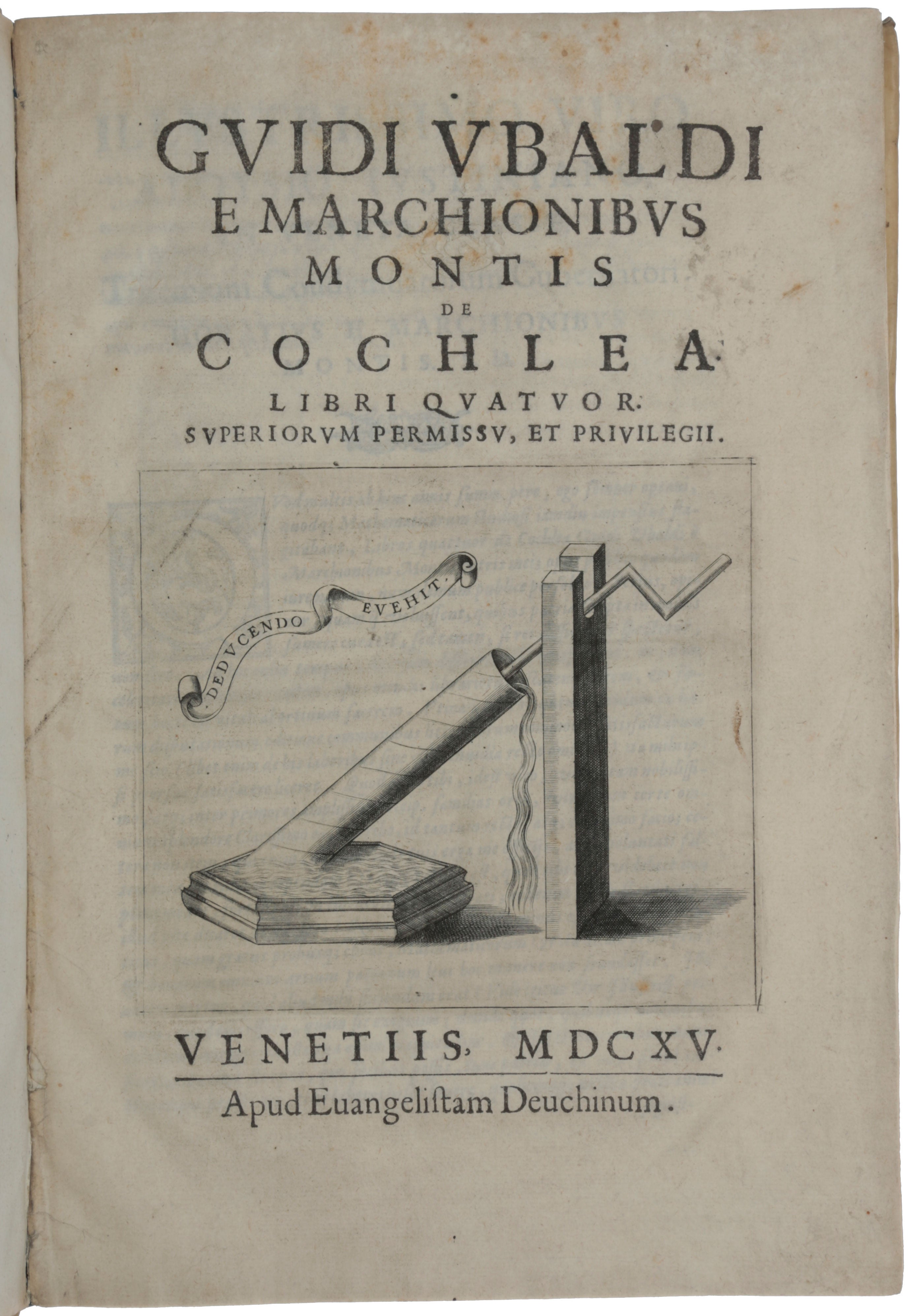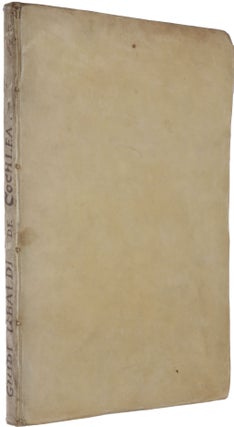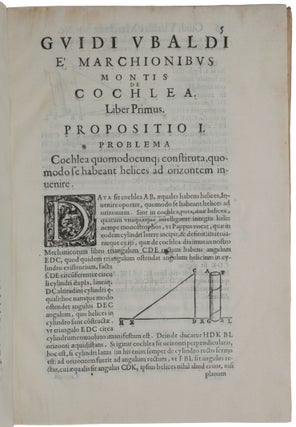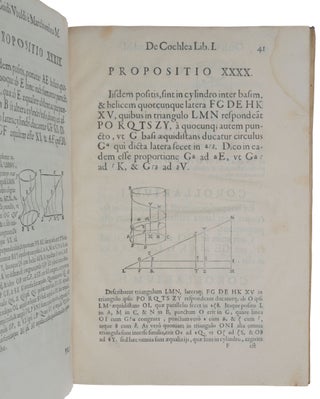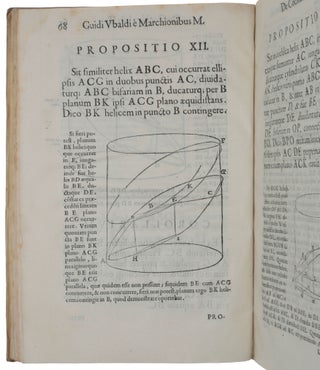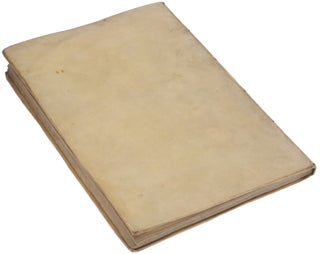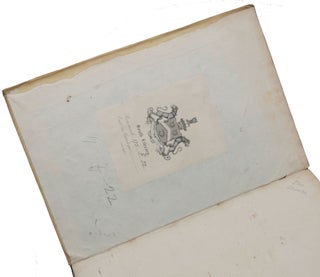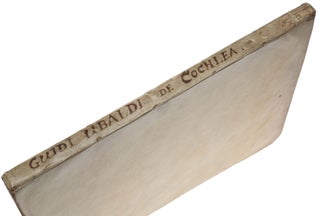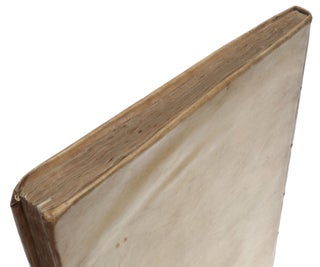De Cochlea Libri Quatuor.
Venice: Evangelisto Deuchino, 1615. First edition, the Macclesfield copy, of this very rare and important work of Renaissance engineering and mathematics, Guidobaldo’s analysis of the theory and operation of Archimedes’ most famous mechanical invention, the ‘cochlea’ or ‘Archimedean screw’. This is a device used for raising water consisting of a helical tube wound around the outside of a cylinder; when the cylinder is inclined at an angle to the horizontal and the lower end of the tube is placed in water, rotating the cylinder causes water to be raised through the tube and ejected from the top. The Archimedean screw, and other variants of it, is still in use today; it is also used in reverse to generate hydraulic power (when water is poured into the tube at the top it causes the screw to rotate). The first to correctly explain the functioning of the Archimedean screw was Galileo: in Le meccaniche (written around 1600 but not published until 1634), he wrote that “the screw-pump ‘is not only marvellous, but it is miraculous’ (‘non solo è meravigliosa, ma è miracolosa’), because in the screw-pump the water ascends by continually descending” (Koetsier & Blauwendraat, p. 188). But De Cochlea is the first printed account of how the screw-pump actually works. “The four books on the cochlea by Guido Ubaldo del Monte (1545-1607) are almost unknown to scholars who studied Archimedes’ machine (perhaps due to the fact that the author used the Latin language in the few copies that were printed and to the different ways in which the author’s name has been spelled over time) … Galileo himself requested a copy of it from Guido Ubaldo” (Magnini & Molari). Guidobaldo’s analysis of the Archimedean screw was not improved upon until the 18th century, when calculus methods (invented by Newton half a century after the publication of De cochlea) were applied to the problem by Daniel Bernoulli in Hydrodynamica (1738) and by Leonhard Euler in his paper ‘De cochlea Archimedis’ (Novi Commentarii academiae scientiarum Petropolitanae 5 (1760), pp. 259-298). “Guidobaldo was Galileo’s patron and friend for twenty years and was possibly the greatest single influence on the mechanics of Galileo” (DSB). Guidobaldo was also influential in securing appointments for Galileo, first at Pisa and then Padua. Together they conducted a series of experiments on the trajectories of cannonballs, asserting that projectiles follow parabolic paths. “After [Federico] Commandino’s death in 1575, the commitment to the restoration of Greek mathematics was carried on by his disciples Guidobaldo dal Monte and Bernardino Baldi, to whom he had taught mathematics from about 1568” (Frank). According to Stillman Drake (p. 35), Guidobaldo was writing De Cochlea in the early 1590s: “In September 1593 Guidobaldo wrote an invitation to Galileo to visit him at Monte Baroccio … His patron wanted to show him a book on perspective he had written but not yet published … Guidobaldo was also writing a book on the Archimedean screw; this was probably related to a patent Galileo obtained in September 1594 on a device for raising water by horse power.” However, Guidobaldo’s book on the screw-pump was not published until after his death more than a decade later, by his son Orazio. ABPC/RBH list no other copy in a contemporary binding since the Honeyman sale in 1978. Provenance: The Earls of Macclesfield (South Library bookplate on front pastedown, small embossed stamp to first three leaves); sold Sotheby’s, April 14, 2005, lot 1439, £2,880 ($5,461). The Archimedean screw is one of the oldest machines still in use. “The earliest representation of a water-screw is on a fresco from the Casa di P. Cornelius Teges in Pompeii, obviously dating from before 79 AD. On the fresco an individual is moving a cylinder with his feet in a landscape that is allegedly Egyptian. Because water comes out of the cylinder it is generally assumed it must be a water-screw. From the imperial period we have two other Egyptian representations (in the British Museum and the Archaeological Museum Cairo, respectively) and an Egyptian model of a water-screw (in the Hilton-Price collection). Moreover, remains of water-screws dating from the imperial period have been found in mines in Spain. None of these representations or remains of water-screws dates from before the time of Archimedes” (Koetsier & Blauwendraat, p. 182). “Its invention has traditionally been credited to Archimedes (ca. 287-212 BCE). For example, Diodorus Siculus (Greek historian, circa first century BCE) writes: ‘men easily irrigate the whole of it [an island in the delta of the Nile] by means of a certain instrument conceived by Archimedes of Syracuse, and which gets its name [cochlias] because it has the form of a spiral or screw.’ And from Athenaeus of Naucratis (Greek historian, circa 200 AD): ‘The bilge-water [of the ship Syracusia], even when it became very deep, could easily be pumped out by one man, with the aid of the screw, an invention of Archimedes’” (Rorres, p. 72). “Drachmann has argued (p. 153) that Archimedes invented the screw-pump after having seen in Egypt the operation of a water-drum or tympanum (a water-lifting wheel with a body consisting of eight compartments). While the tympanum rotates, water enters a compartment through a hole close to the periphery of the drum, and after half a turn the water leaves the compartment again through a hole close to the axis. Oleson, who sympathises with Drachmann’s reconstruction, described the moment of Archimedes’ breakthrough as follows (p. 298): ‘if the tympanum were to be drawn slowly along the axis of its rotation as it turned, its compartment walls would describe the spirals of just such a screw’” (Koetsier & Blauwendraat, p. 183). Koetsier & Blauwendraat argue that Archimedes may have been led to the discovery by his interest in the problem of the quadrature of the circle, equivalent to the problem of constructing by ruler and compass a straight line segment with length equal to that of the circumference of a given circle. This problem was shown in the 19th century to have no solution, but Archimedes showed that a solution could be given if one used, in addition to ruler and compass, a certain planar spiral curve. Archimedes’ interest in spiral curves would undoubtedly have extended to the circular helix used in the construction of the screw-pump, and this curve can also be used to effect the circle quadrature. The oldest known description of the Archimedean screw is in the Roman engineer and architect Vitruvius’ De Architectura (composed about 25 BCE). Vitruvius’s description contributed greatly to keeping the device well known throughout the ages. Leonardo da Vinci illustrated the Archimedean screw in the Codice Atlantico, and other Renaissance accounts of the Archimedean screw can be found in Cardano’s De Subtilitate (1550) and Ramelli’s Le Diverse et Artifiose Machine (1588). But it was Galileo who first clearly understood how the Archimedean screw pump actually works. The tube which carries the water is in the form of a helix wrapped around the cylinder. Such a helix can be constructed by taking a right-angled triangle and wrapping the base of the triangle around the circular base of the cylinder; the hypotenuse of the triangle then becomes the circular helix. The angle between the hypotenuse and the base is the ‘angle of inclination’ of the helix. If the Archimedean screw is placed in the vertical position it will not work as any water in the helical tube will simply flow to the bottom under gravity. But suppose now that the pump is inclined at a steadily increasing angle to the vertical; when this angle is equal to the angle of inclination of the helix, at some points the helix will be horizontal. If the angle is increased further, some parts of the helix will slope upwards and others downwards. Since water in the tube cannot flow upwards, it collects in ‘pockets’ in the tube. As the Archimedean screw is rotated, these pockets are carried to the top of the cylinder. As Galileo remarked, the water is carried upwards at the same time as it continually descends into one of the pockets. De Cochlea is divided into four books. The first is devoted to the geometry of helical curves, and the second to the volumes of water being separated inside the screw. The third book takes into account the flow of water and gives a clever approximate description of the ‘pockets’ in which the water inside the tube collects. The fourth book deals with some extensions of Archimedes’ design: multi-channel screws and a new curve obtained by wrapping the circumference of a circle around a cylinder. “After two pages in which Orazio dedicates the book written by his father to Luigi Giustiniani, captain of the Venetian fleet, the goals Guido Ubaldo aims to reach are detailed: ‘As regards this cochlea, things are different: in fact, when we see water going upwards due to the action of this machine, we are, indeed, surprised because we imagine that this effect is produced by some sort of contrivance; and, as usually happens for this sort of thing, when we become aware of it, the wonder ceases and we remain little surprised; however, after knowing the actual reason for this kind of motion [of the water], not only does the wonder not cease, but it grows considerably, as we appreciate that, in this case, water is lifted up, whereas it usually falls; therefore, in this case, the cause producing the effect is worth the wonder, rather than the effect itself, whereas for other things, it is usually the fact that amazes rather than its cause. Indeed, all the causes of the mechanical effects do not fail to astonish, as we stated in our comments on the books written by those who admire Archimedes, but between this and other mechanical things, there stands a difference: in the other things, once the cause is known, the wonder does not cease, whereas in this case, the wonder increases, it grows, so that this thing seems extraordinary. ‘It’s no wonder that, after people from both ancient times and the more recent past have written about this machine, we also dared to study it. I admit that they all have discussed this cochlea to a great extent, but they totally neglected certain important aspects regarding the perfect knowledge of this machine. In fact, they explain, or rather they just state (this is what we actually have understood from what we have read) that water is lifted up by this machine, but they do not explain how this is realised, so that, despite the fact that many papers on this cochlea can be found and [even though] this machine has been manufactured by men’s own hands, it is not out of place to state that [the cochlea] has been left misunderstood over the centuries as nobody has really shown themselves to have understood it properly … ‘Where this effect comes from, that is, how it can happen that water is lifted up by the cochlea, is what we are going to explain to the best of our abilities, so that the exact cause of this effect can be understood; the research, to be fair, is an acute one and worth being known.’ “The first book deals with different geometrical demonstrations of the geometry of the helix and the length of the water trajectory in a slice of the rotating drum. Guido Ubaldo treats the definition of the helix through the generating triangle (figure, p. 5), then he considers the generating triangle at different positions of the cochlea (figure, p. 9). In the second proposition, he writes, ‘Find the angular disposition of the cochlea so that the water can flow into the helix (can fill up the inside of the cochlea)’” (Magnini & Molari, pp. 259-260). In the second book, Guidobaldo uses the geometrical results in the first book to determine the extent of the ‘pockets’ in which water accumulates inside the pump. This is illustrated in the figure on p. 75. With the screw-pump inclined to the vertical at an angle greater than the angle of inclination of the helix, Guidobaldo locates the points such as K at which the distance from the horizontal plane on which the screw-pump rests is a maximum; at these points the tangent to the helix is horizontal. The horizontal plane passing through K intersects the cylinder in an ellipse, which in turn intersects the helix at a second point O. All the points of the arc EO of the helix are below E and O, so water contained there will be in equilibrium. This ‘pocket’ EO was later referred to as an ‘arc hydrophore’. “[The third] book consists of a brilliant description of the physical behaviour of the machine. Here, all the theorems on the intersections treated in the previous books are taken into account to construct the geometrical model of the machine. The machine is reduced to a small tube wrapped around the cylinder [see the lower diagram on p. 118]. Then the cross-section of the tube is reduced to a point. The helix obtained in this way allows us to measure the volume [of water in the tube] by means of a one-dimensional curve” (Magnini & Molari, pp. 261-262). Guidobaldo attempted to determine the length of the arc hydrophore using proportions between segments, but in this he was unsuccessful and this may explain why he did not publish the book during his lifetime. He did, however, give an approximate method which is illustrated in the diagram on p. 110. “The following sentences from this book will better explain these concepts. ‘Only a small portion of the water will enter the helix, and it will certainly move from L to TV [see the figure on p. 116], but when the water arrives at T, it will stay there because of its nature, as T is the lowest locus; indeed, it will not move from T towards L, as it would [have to] move from a locus at a lower position to one at a higher position, which cannot occur. Knowing this, when the [shaft of the] cochlea is turned again, it appears clear that the volume [of water], during the revolution of the [shaft of the] cochlea, will always stay in the lower part of the helix. ‘Then, water immediately moves towards the lowest position, located on the line IN, as along the helix LTV another one starts right next to it, and another one next to this, and so on, in such a way that water falling down along the helix will almost always stay along the line IN, and one has to imagine that in this manner it will move from H to X and from X to N. Then, as soon as the water, because of its motion, arrives at the top of the helix, it will flow out, as N is the lowest position, being along the line IN … ‘But, as water has also another nature, so that it somewhat equilibrates itself until its surface is parallel to the horizontal, when it enters [the helix] in L and falls down to T, since more and more water enters, it will move until it gets to the surface YS at P and then it will remain there and no more water will enter and this amount of water in LTP, trapped there, will be the amount of water that the cochlea can take in this position. ‘The same cochlea, the more it is inclined, the more water it will lift [see the figure on p. 132].’ “With the aim of finding the extreme points of the arc hydrophore, Guido Ubaldo discovered [in the fourth book] a new curve [obtained by] wrapping a circumference [of a circle] around a cylinder, as the end point of helices of the same length [see the figure on p. 136]. Some properties of this new curve are considered. Guido Ubaldo tries to determine the maxima and minima of the helix [by] taking the [angle of inclination of the helix] as a parameter, considering the circumference passing through them, and referring the angle to the projection of the end point of its radius, as shown in [the diagram on p. 157] … “We had to wait until the industrial revolution in France to get an improvement on Guido Ubaldo’s studies. [Henri] Pitot seems to have been the first to consider modelling the cochlea, as Guido Ubaldo did, as a helix and describing the inclined helix in an analytical way, using differential geometry to get the maximum and minimum points of the curve in space [‘Theorie de la vis d’Archimede,’ Histoire de l’Académie Royale des Sciences (Paris), 1736, pp. 173-183]. This approach was essentially geometrical, hence quasi-static with respect to the motion. Later, the Academy of Belgium proposed an award (ca. 1766) to get a dynamic description of the flow inside the machine. [Johann Friedrich] Hennert, who was the winner, retraced the path followed by Pitot, adding some experiments on the dynamics of the machine” (ibid., p. 265). The operation of the Archimedean screw is complex and, even in modern times, approximation methods have to be used to describe it (see Rorres). Guidobaldo del Monte was one of the most prominent Italian mathematicians from the second half of the sixteenth century. He was a nobleman from the Duchy of Urbino and occupied a central position at the courts of the Dukes Guidobaldo II and Francesco II della Rovere for large parts of his life, until he fell out of favour in the 1590s. He studied mathematics at Padua, and later at Urbino he became the friend and pupil of Federico Commandino, whose translation of Pappus he edited and published in 1588. He combined practical work as an architect, designer of instruments, and surveyor of fortifications, with theoretical works on astronomy, perspective and mechanics. In cosmology he appears to have been an orthodox Aristotelian, as judged by his reaction to the supernova of 1604. Notwithstanding this latter position, he was also one of the most important patrons of the young Galileo. Together with his brother, Cardinal Francesco Maria del Monte (well known for having been a patron of Caravaggio), he helped Galileo secure his first teaching positions at the University of Pisa (in 1589) and Padua (in 1592). His first book, the Liber mechanicorum (1577), was regarded by contemporaries as the greatest work on statics since the Greeks and his Perspectivae libri sex (1600) is considered the best Renaissance study of perspective. BL/STC 17th-century Italian Books II, p. 589; Brunet V, 996; Griffante, Ed. Veneziane Seicento D-26; Poggendorff II, 193; Riccardi I (ii), 180.7. Drachmann, ‘The screw of Archimedes,’ Actes du VIIIe Congrès international d’Histoire des Sciences 3 (1956), pp. 940-953. Drake, Galileo at Work, 1978. Frank, ‘The Curious Case of QP.6: The Reception of Archimedes’ Mechanics by Federico Commandino and Guidobaldo Dal Monte,’ Revue d’Histoire des Sciences 68 (2015), pp. 419-446. Koetsier & Blauwendraat, ‘The Archimedean screw-pump: a note on its invention and the development of the theory,’ pp. 181-194 in: International Symposium on History of Machines and Mechanisms (Ceccarelli, ed.), 2004. Magnini & Molari, ‘Archimedes’ Screw in the Four Books De Cochlea by Guido Ubaldo del Monte,’ pp. 255-271 in: Essays on the History of Mechanical Engineering (Sorge & Genchi, eds.), 2016. Oleson, Greek and Roman Mechanical Water-Lifting Devices: The History of a Technology, 1984. Rorres, ‘The turn of the screw: optimal design of an Archimedes screw,’ Journal of Hydraulic Engineering 126 (2000), pp. 72-80.
Small folio (311 x 212mm), pp. [iv], 160, title page with engraved vignette and motto “Deducendo evehit”, woodcut initials, head- and tail-pieces, numerous woodcut diagrams in text, printed marginal notes (title page a little soiled and foxed, faint damp-stain to upper outer margin of a few leaves, a few corrections in ink in the text as in other copies, presumably by the author or publisher). Contemporary vellum, handwritten title on spine (a little soiled). A fine, crisp, unpressed copy.
Item #5425
Price: $12,500.00

